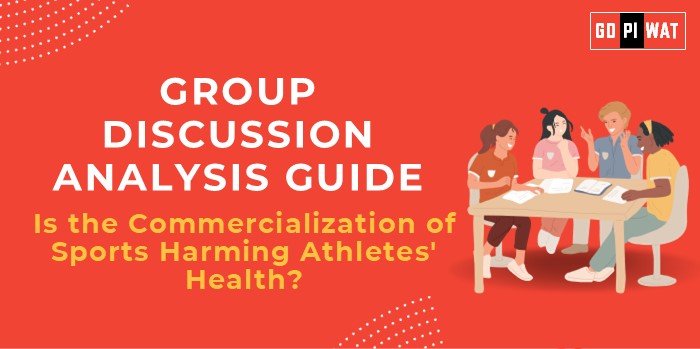📋 Group Discussion Analysis Guide
⚽ Is the Commercialization of Sports Harming Athletes’ Health?
🌐 Introduction to the Topic
Opening Context: Sports have evolved from a passion-driven activity into a multi-billion-dollar industry, bringing fame and fortune to athletes but often at a cost to their well-being.
Background: The increasing commercialization of sports, driven by corporate sponsorships, media rights, and advertising, has raised concerns about its impact on athletes’ health—both physical and mental.
📊 Quick Facts and Key Statistics
- Global Sports Market Value: $600 billion in 2023, showcasing the massive financial stakes in sports.
- Injury Rates: Professional athletes face a 50%-75% higher injury risk during commercial tournaments compared to regular-season games (Source: Sports Injury Journal 2023).
- Burnout Cases: 1 in 4 elite athletes report severe stress or burnout due to extended seasons and commercial obligations (Global Athlete Survey, 2022).
- Advertising Revenue Influence: Over 60% of tournament schedules are influenced by advertising partnerships (World Sports Council Report, 2023).
👥 Stakeholders and Their Roles
- Corporate Sponsors: Drive financial growth but often prioritize profit over athletes’ health.
- Media Houses: Demand higher game frequency for increased viewership, pressuring players.
- Sports Organizations: Balance athlete welfare with revenue generation.
- Athletes: Bear the physical and mental burden of demanding schedules.
- Fans: Drive commercialization through their engagement and expectations.
🏆 Achievements and Challenges
Achievements:
- Financial Security: Athletes earn lucrative contracts, securing their future.
- Global Reach: Increased exposure boosts opportunities for athletes worldwide.
- Enhanced Facilities: Better training and healthcare investments from sponsorships.
Challenges:
- Overexertion: Packed schedules lead to injuries and burnout.
- Mental Health Impact: High-pressure environments cause stress, anxiety, and depression.
- Inequity: Only top-tier athletes benefit financially, leaving others behind.
🌏 Global Comparisons
- USA: The NBA and NFL prioritize athlete welfare with mandatory rest days.
- Japan: Baseball leagues restrict consecutive games to prevent burnout.
📖 Case Studies
- Serena Williams (Tennis): Opened up about mental health struggles despite her success.
- Simone Biles (Gymnastics): Withdrew from the Olympics, citing mental health concerns.
📝 Structured Arguments for Discussion
- Supporting Stance: “Commercialization has raised athlete earnings and improved sports facilities.”
- Opposing Stance: “Increased commercialization compromises athlete health due to excessive stress and injuries.”
- Balanced Perspective: “While commercialization provides financial growth, balancing athlete health and tournament demands is crucial.”
📖 Effective Discussion Approaches
- Opening Techniques:
- Data-Driven Start: “Did you know that commercialization in sports generates $600 billion annually but also increases athlete injuries by 75%?”
- Question-Based Approach: “Are athletes paying too high a price for the commercialization of sports?”
- Counter-Argument Handling:
- Example: “While athletes earn more through sponsorships, the rising cases of mental health issues like Simone Biles’ withdrawal highlight underlying concerns.”
🔍 Strategic SWOT Analysis
- Strengths: Financial stability, global recognition.
- Weaknesses: Injury risks, mental health challenges.
- Opportunities: Innovations in athlete healthcare.
- Threats: Long-term health damage, career shortening.
🎓 Connecting with B-School Applications
- Real-World Applications: Use in leadership studies, HR strategies, and wellness programs.
- Sample Questions:
- “What policies would you implement to balance sports commercialization with athlete health?”
- “How can sports organizations mitigate mental health risks for athletes?”
- Insights for Students: Develop wellness programs or analyze case studies of athlete management for internships.


